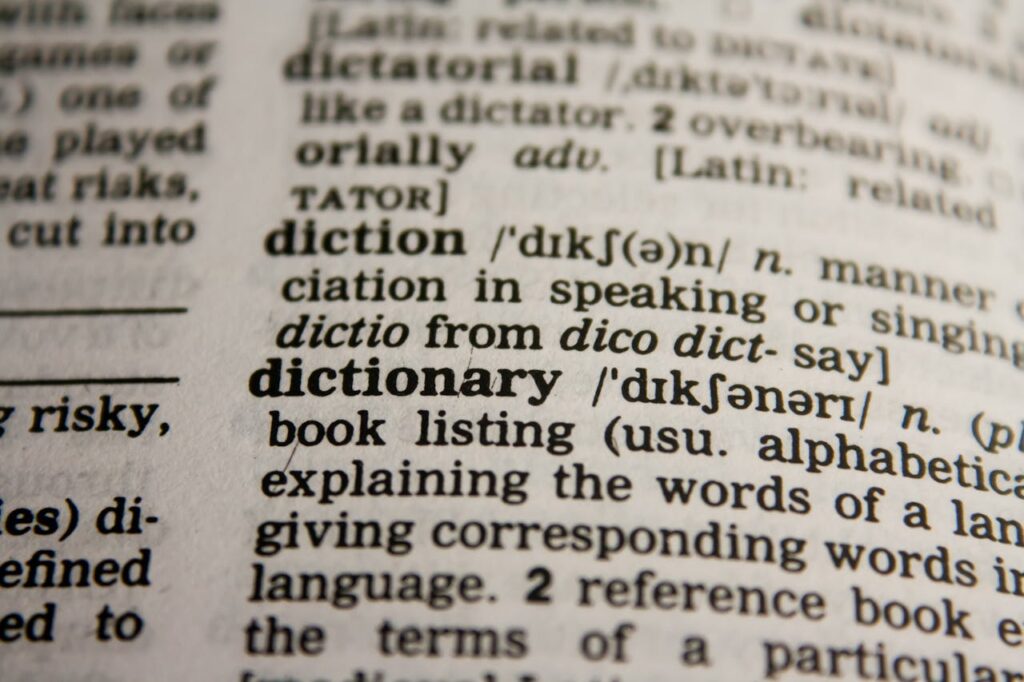
CFI "Gun Talk" Dictionary
Taking your first steps into the “gun world” can be tough when you don’t speak the same language as the people you’re learning from! A huge struggle new shooters run into is not understanding the “lingo” of the gun world. Ever found yourself in a conversation on the range, reading an article online, or studying a YouTube video and realize you spent the last 10 seconds just trying to figure out the meaning of some word or phrase you just heard? CFI’s survival gun talk dictionary is built for new shooters to give them a “gun-talk” to english translation. We’re going to be updating constantly and want to know your feedback about new terms you need to know.
A
- ACCIDENTAL DISCHARGE (A.K.A “AD”) — The unintentional firing of a gun due to circumstances not in the control of the shooter while handling a firearm. The cause of an “AD” is usually mechanical in nature. (see also negligent discharge).
Example:“Keep that gun pointed in a safe direction, ADs can happen at any time”
- ACTION – The physical mechanism that manipulates cartridges (sets it in the chamber for firing and removed the casing after) and/or seals the breech.
Example:”Leave the Actions open showing an empty chamber”
- ACP – An abbreviation for “Automatic Colt Pistol”. Often used to talk about particular calibers developed for Colt Firearms way back when. Examples (From most to least common) – .45 ACP, .380 ACP, and .25 ACP
- AIM or AIMING – The umbrella term meaning the combination of your Sight Picture and your Sight Alignment.
- AMMUNITION or “AMMO” – (Also referred to as “rounds”) The assembly of the Primer, Casing, Gunpowder and projectile into a single Cartridge to be shot out of a firearm.
Example: “Before we hit the range I gotta stop off and buy some ammo”
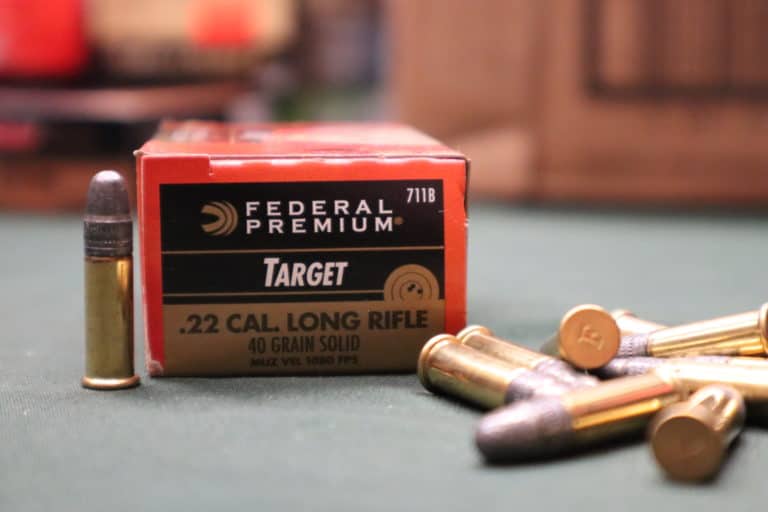
- AR / AR-15 – While not having to do with handguns I added this one out of necessity. A very common semi-automatic rifle, usually black with a pistol grip. (The AR does not stand for “assault rifle” or “automatic rifle”, but actually for the company that originally built it, Armalite.)
- ASSAULT RIFLE – Military firearm capable of shooting rifle rounds in both fully-automatic and semi-automatic modes.
- ASSAULT WEAPON – Nonsense made up by media and politicians loosely having to do with cosmetic additions to given semi-automatic (not automatic) firearms.
- AUTOLOADER – Any gun that automatically loads the next round of ammunition upon pulling of the trigger. (Also, semi-automatic)
B
- BALL AMMUNITION – Originally meant ammunition that was actually a sphere, now used to refer to round nosed, fully jacketed ammunition.
- BALLISTICS – The science of the motion of projectiles (bullets) in flight. This also includes the flight characteristics of a projectile or the study of the processes within a firearm as it is fired (internal/external ballistics).
- BARREL – The hollow metal tube down which your bullet (projectile) travels to exit the firearm.
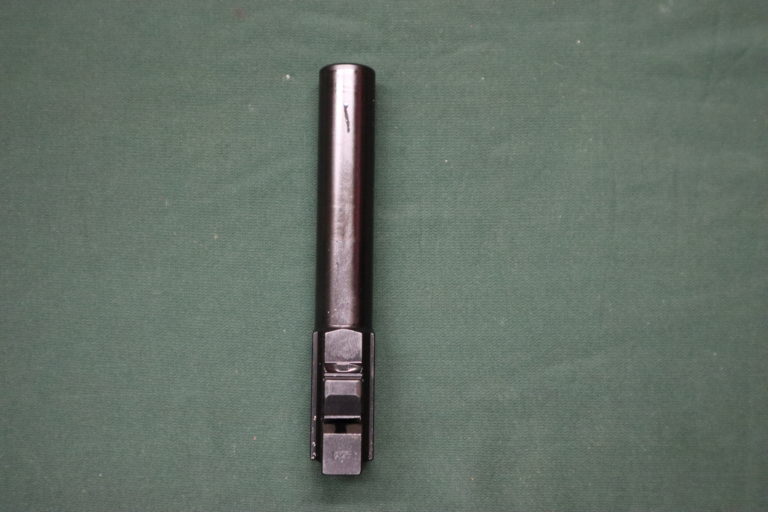
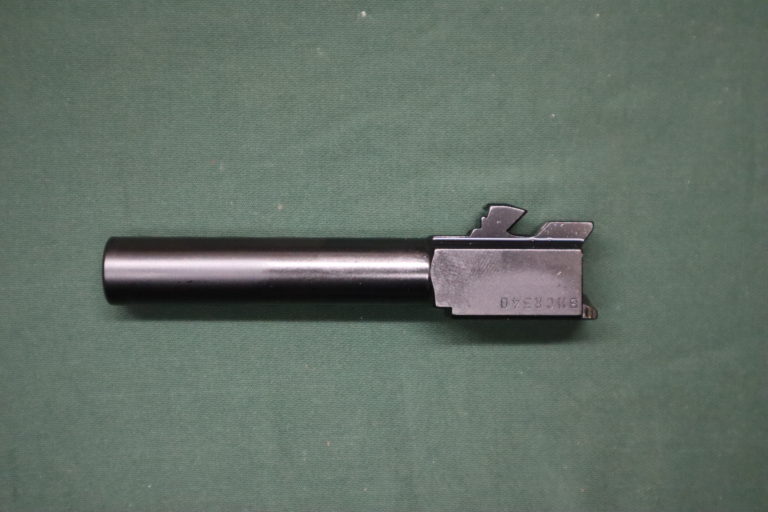
- BATTERY (or “in-battery”) – When the breech has been fully closed and locked and is ready to shoot. A gun that is “out of battery” (breech not fully closed, ammunition not fully seated) should not, and most often, cannot be fired.
- BACKSTRAP – the “strap” on the back of your handgun grip. The part that most likely comes in contact with the heel of your shooting-hand.

- BEAVERTAIL – Large piece of curved metal or plastic at the top of a handgun grip. Found on nearly all 1911 models, this serves as a great way to make sure your shooting-hand grip is as high on the gun as it can safely be while keeping your hands clear of the slide moving backwards.

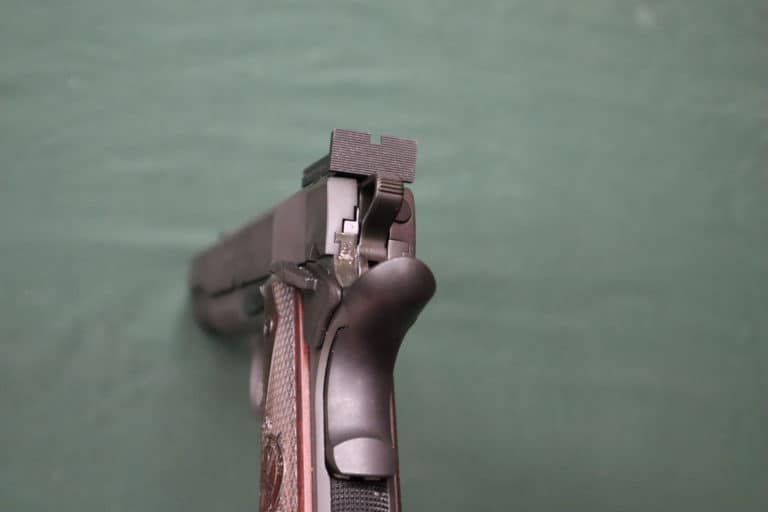
- BLANK – A type of cartridge that contains all the elements of live ammunition EXCEPT for the bullet (the projectile). When a blank is fired it acts and sounds exactly like a normal cartridge (flash, explosion, etc) BUT, as there is no bullet, no projectile is fired from the gun. Blanks are used in training, or as special effects in movies, and as signaling devices like starter pistols.
- BERM – A large pile of dirt placed behind targets on a shooting range (outdoors) built to stop bullets.
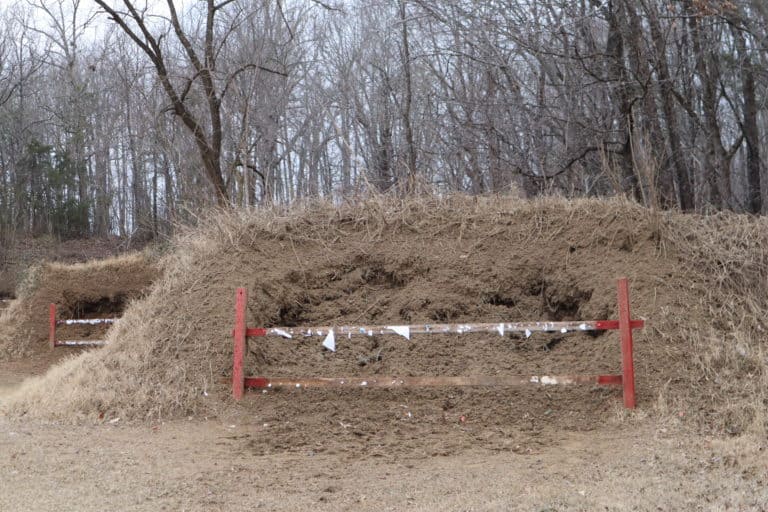
- BLACKPOWDER – The earliest known chemical explosive. Originally just called “gunpowder” with the name being changed to distinguish it from the more common, modern, “smokeless” powder.
- BLOWBACK – A system of operation for self loading firearms. Your handgun obtains and uses the power from the motion of the cartridge case as it is pushed to the rear by the expanding gasses (created by the ignition of the gunpowder charge) to clear and eject the spent round, and to reload the next live round into the chamber.
- BLUING – An electro-chemical conversion coating used by gun manufacturers, owners, and gunsmiths to improve the cosmetic appearance of, and provide a measure of corrosion resistance to, their firearms.
- BORE – The hollow center of a barrel through which the bullet travels once being fired.
SEE ALSO:
-
- SMOOTH-BORE – A firearm that does not have rifling on the inside of the barrel.
- BIG-BORE – A firearm that fires a large caliber round.
- SMALL-BORE – A firearm fires a small caliber round.
- BORE AXIS – An imaginary line running down the middle of the handgun’s barrel, out the back end of the gun.
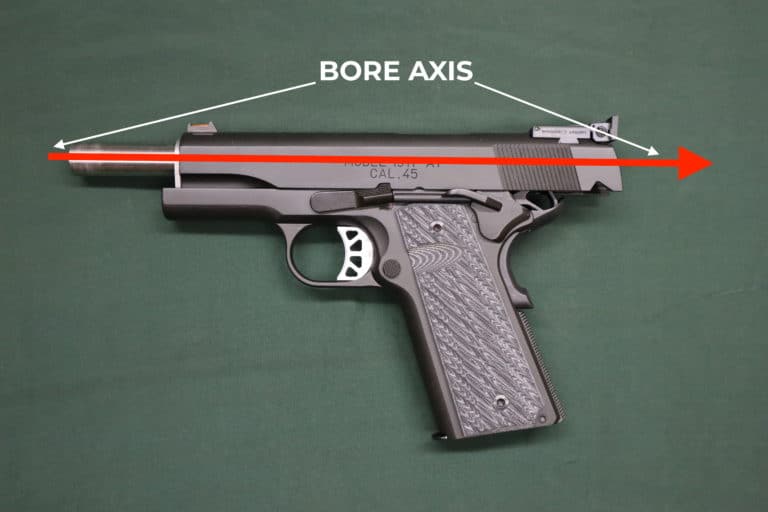
SEE ALSO:
-
- SMOOTH-BORE – A firearm that does not have rifling on the inside of the barrel.
- BIG-BORE – A firearm that fires a large caliber round.
- SMALL-BORE – A firearm fires a small caliber round.
- BORE AXIS – An imaginary line running down the middle of the handgun’s barrel, out the back end of the gun.
SEE ALSO:
-
- HIGH BORE AXIS – The imaginary line runs well above your hand no matter how high up on the grip you hold the firearm. You will usually feel that a gun with a high bore axis has more recoil.
- LOW BORE AXIS – The line runs into your hand or very close to the top of it. The energy from the explosion of firing a round is sent more directly into your hand and you will feel as if there is less recoil or “muzzle flip” when you shoot.
- BORE SNAKE – A caliber specific tool used to clean the interior of your gun barrel. Typically a weight connected to a string, connected to a caliber-specific sized length of cleaning cord with scouring bristles attached. Bore snakes are good for doing a quick job of all aspects one needs to clean on a barrel all at once.

- BORESIGHT – Crude adjustments made to an optical firearm sighting system to align the firearm’s barrel and sighting system. This method is usually used to pre-align the sights, making “zeroing” (see below) your firearm much faster and easier.
- BRASS – An empty cartridge case. (What gets ejected by your semi-automatic pistol after firing, for example.)
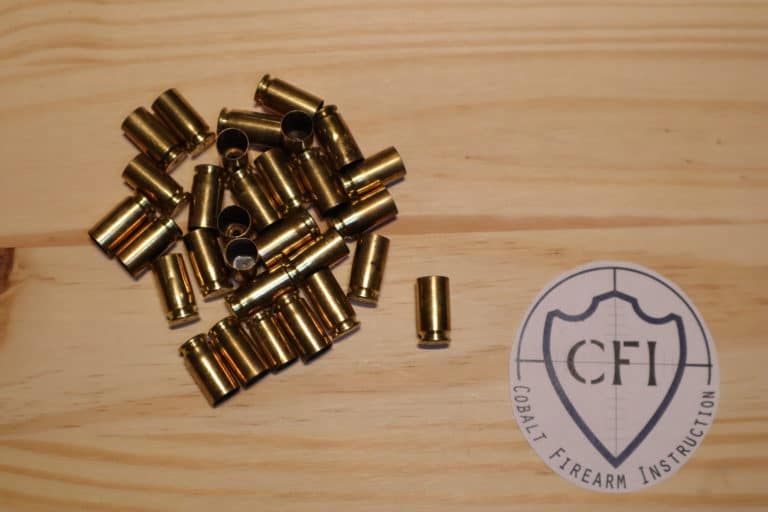
- BREAK or “TRIGGER BREAK” – The point at which the trigger releases the striker or lets the hammer fall, firing the shot.
SEE ALSO:
-
- “CLEAN BREAK” – A crisp and sudden trigger break. No mush just before the round goes off.
- BREECH – The rear-end of the barrel (facing the shooter as the gun is held in a shooting position), containing the chamber part of the barrel.
- BREECH PRESSURE – The amount of rearward force exerted by the propellant gases on the bolt or breech of a firearm action when a projectile (bullet) is fired.
- BRICK – Term often used to describe a 500-round container of .22 Long Rifle ammunition. Winds up looking like/weighing about the same as, a brick.
- BUFFER – A component that reduces the velocity of recoiling parts of your firearm (such as the bolt.)
- BULLET – Projectile portion of a cartridge, (or round of ammunition). The nose of the cartridge that is sent downrange when the round is fired.
- BUTT – The bottom / base of the grip on a handgun. For rifles, it is the rearmost part of the stock that rests on your shoulder while you shoot.
C
- CALIBER or CALIBRE – In handguns, the internal diameter of a firearm’s barrel, or the diameter of the bullet. Caliber is usually expressed in hundredths of an inch or in millimeters. So, a 38/100ths of an inch internal barrel diameter (or a 38/100ths of an inch bullet diameter) makes for either a .38 caliber handgun, or .38 caliber ammunition. In the metric system, a 9/1000ths of a meter internal bore diameter is that of a 9mm handgun.
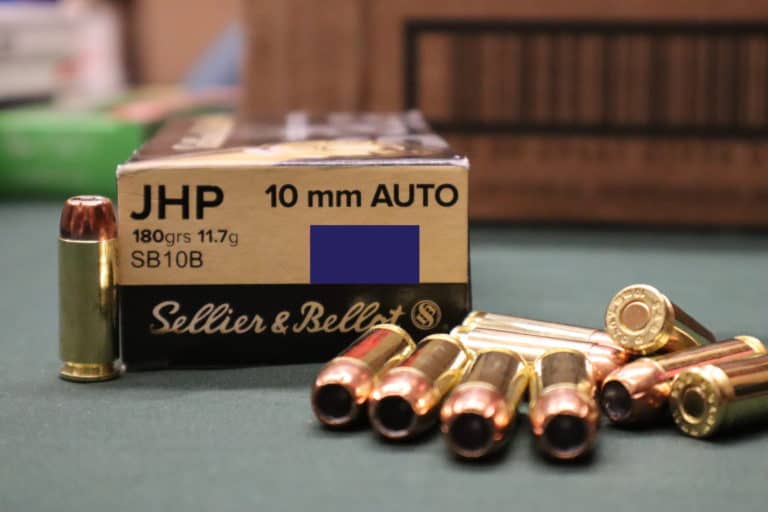
- CAN – Another term for a suppressor (instrument used to muffle the sound of a gunshot.)
- CANT – Tilting the firearm slightly to one side or the other. This can be in reference to the way in which a shooter holds the firearm while shooting, or the way in which they carry their gun in a holster.
- CARTRIDGE – The full assembly of a round of ammunition consisting of the Primer, the Casing, the Gunpowder and the Bullet (projectile).
SEE ALSO:
-
- When counting, such as loading your handgun magazine or cylinder, it can be called a “round” – for example – “I’ve loaded 5 rounds into your magazine.”
- CASE or CASING – The “container” of a cartridge containing the gunpowder. For rifles and handguns it is usually made of brass or other metal.

- CENTERFIRE – A cartridge in which the primer is located in the center of the cartridge case head. (the bottom center of the cartridge.)
- CENTER-MASS or “CENTER OF MASS” – The area in the torso where a bullet will likely cause the most damage to the vital organs contained. Shooting for Center Mass is an effective and common tactic in self-defense shooting.
- CHAMBER – The rear portion of the barrel or firing cylinder in which the cartridge is inserted prior to firing. Semi automatic Pistols have a single chamber in their barrels, while revolvers have multiple chambers in their rotating cylinders and no chamber in their barrels.
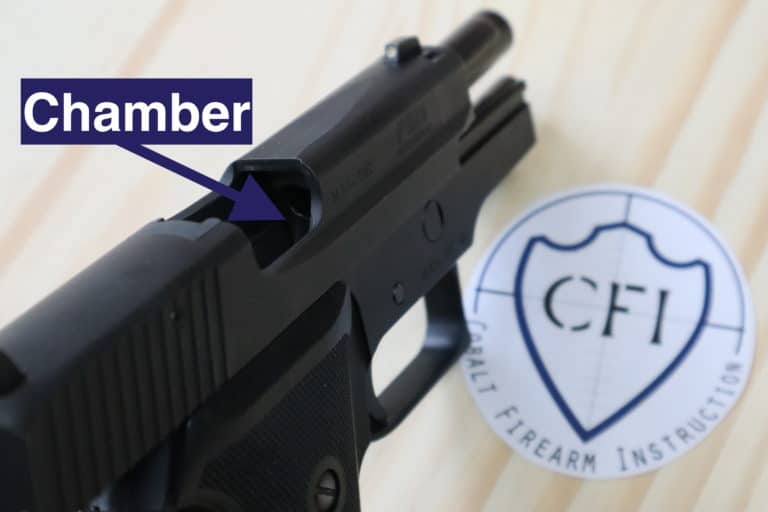
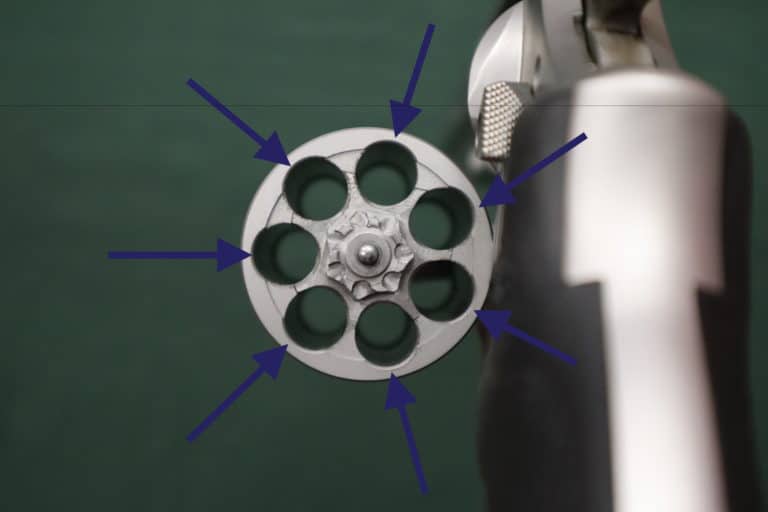
- CHAMBERING or “CHAMBERING A ROUND” – The act of inserting a round into the chamber of a firearm, either manually or through the action of the firearm. When a cartridge has been seated in the chamber and is ready to fire, it is called “chambered.”
- CHOKE – A tapered constriction of a shotgun barrel’s bore at the front (muzzle) end. The job of a choke is to shape the dispersion of the pellets for greater accuracy and range.
- CLEAN – “clean” can have a few different meanings in shooting. You can “clean” your gun and remove the dirt. You can have a “clean” target which you have yet to shoot. You can shoot a “clean” run when competing where you’ve made no errors and missed no targets
- CLEARING – There are two main contexts in which you will hear the word “clearing”:
- Unloading – removing ammunition from your firearm and double-checking to make absolutely certain that it is empty.
- Malfunctions – whether you’re dealing with a jam, a misfire, hangfire, or any other kind of ammunition-related malfunction, “clearing” can also refer to the fixing of the malfunction and removing obstructions so the gun is ready to fire again.
- CLIP – Common misnomer for magazine. Magazines are the ammunition storage and feeding mechanisms. Magazines may be internal and attached to the firearm (fixed) or removable (detachable). A clip is a device used to store multiple rounds of ammunition together, ready to be loaded into a magazine or a cylinder of a firearm.
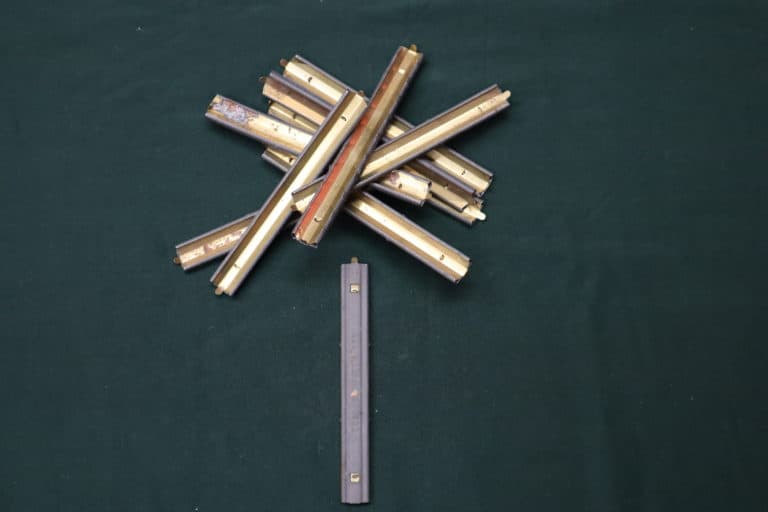
- COCK – Physically drawing or pulling the hammer back against its spring until it becomes latched against the sear, arming the hammer to be released and fall by a pull of the trigger. Some external hammers, and all internal hammers, may be cocked simply by pulling the trigger.
- COLD RANGE – A range on which firearms are not to be handled outside their case, nor are they to be fired until the range goes “hot” and you are instructed to handle firearms by the Range Officer.
- COLLATERAL DAMAGE – Damage that is unintended or incidental to the intended outcome.
- CROSS-DOMINANT– Your dominant hand and your dominant eye are opposite. You shoot right handed but you’re left-eye dominant, and vice-versa.
- CYLINDER – The rotating ammunition holder in a revolver. Comprised of (usually) 5-7 chambers to hold cartridges, the cylinder rotates either to the left or to the right when the hammer is cocked.
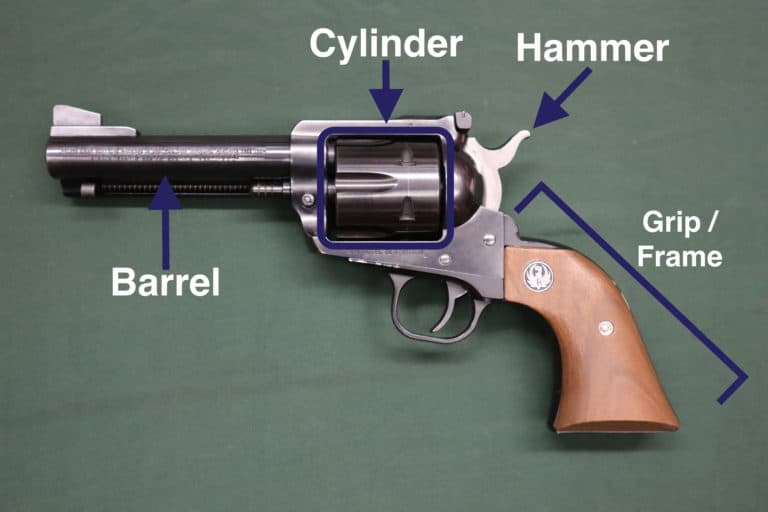
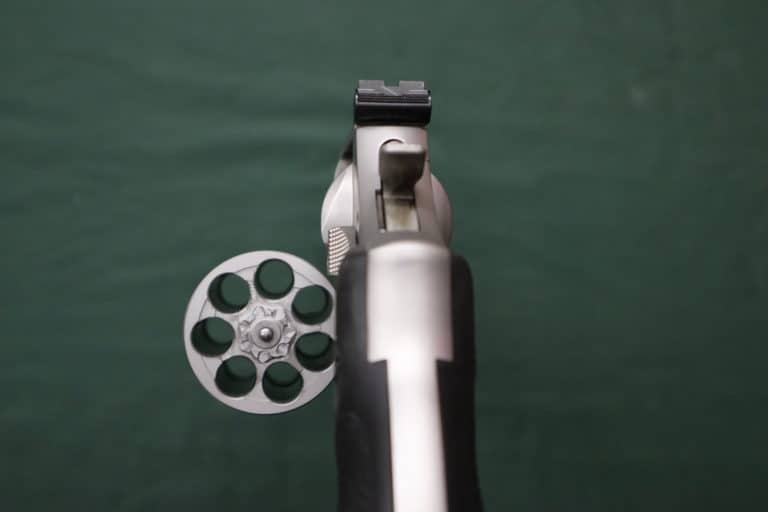
D
- DECOCKER – A lever on double-action semi-automatic firearms that allows you to mechanically lower the hammer without firing the gun.

- DOUBLE ACTION (DA)– A type of firearm that you can shoot either by: 1. Manually cocking the weapon and then pulling the trigger or 2. By pressing the trigger to both cock and fire the weapon with one action. A Double Action trigger pull is typically longer and heavier than a single-action or a striker fire pull. In a revolver this action also rotates the cylinder to the next chambered round.
- DOUBLE ACTION / SINGLE ACTION (DA/SA) – A type of firearm that is designed to operate in double action on the first shot, and in single action on the second shot as well as all shots thereafter until you load a new magazine.
- DOUBLE-ACTION ONLY (DAO) – A type of firearm in which the firing mechanism cannot be cocked to a single-action stage. All Firing must be done “double-action” – pulling the trigger to both cock and fire the gun at once.
- DOUBLE FEED – A malfunction in which the spent case blocks the chamber of a semi-automatic firearm after failing to eject properly. As a new round is brought forward it cannot enter the chamber. It is cleared by removing (sometimes forcefully) the magazine from the gun, racking the slide multiple times to eject the spent case, and then reloading.
- DOUBLE TAP – Two shots fired very rapidly at the same target. Generally done without getting a new sight picture on the target after the first shot. If the second shot is fired after a second sight picture is captured it is usually called a controlled pair.
- DROP SAFETY – A mechanical safety that keeps the gun from going off when it is dropped.
- DRY FIRE – *Most likely something you’ve heard me talk about multiple times if we’ve spent any time on the range together whether personally or professionally* Dry Fire is the practice of firing a a firearm without ammunition. That is, to pull the trigger and allow the hammer or striker to drop on an empty chamber. Dry Firing is used to practice good trigger control and sight alignment skills without expending any ammunition and can be done anywhere, even in the comfort of ones own home. **YOU MUST CHECK MULTIPLE TIMES AND THOROUGHLY THAT YOUR FIREARM IS INDEED COMPLETELY EMPTY WITH NO AMMUNITION AROUND BEFORE DRY-FIRING.
- DUD – A round of ammunition that does not fire due to a number of possible defects.
- DUM DUM or EXPANDING BULLETS – Term for a bullet designed to expand its size upon impact, increasing its diameter so as to limit its penetration distance into a target/and or to produce a larger diameter of damage to the target. The two typical designs are the hollow point bullet and the soft point bullet.
E
- EARS – Slang for hearing protection (earmuffs, earplugs, etc.) The use of specially designed shooting ear protection is required by many, recommended by all (who know what they’re talking about). Many guns are so loud that a single shot can can cause permanent damage to unprotected ears.
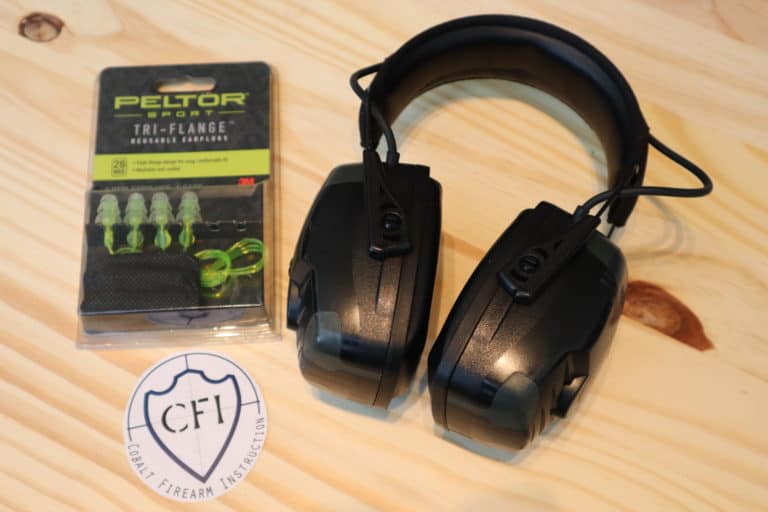
- EJECTOR – A spring-activated mechanism for the ejection of ammunition or and empty shell casings.
- EJECTION PORT – The opening through which empty ammunition casings are ejected from the firearm.
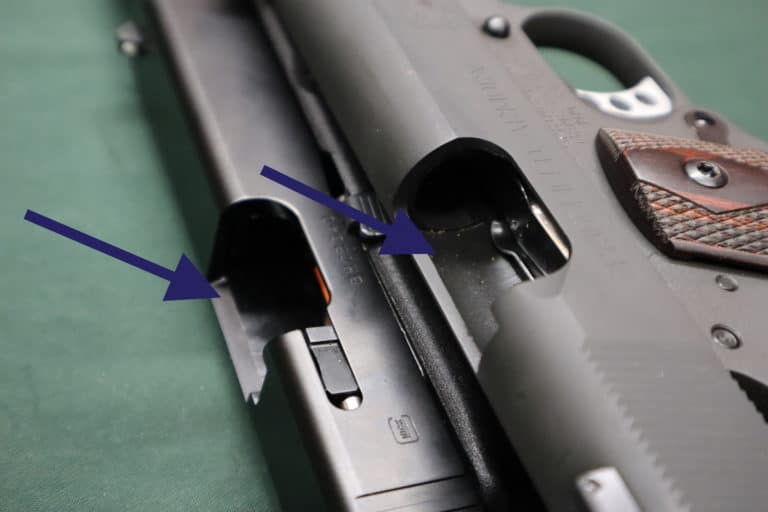
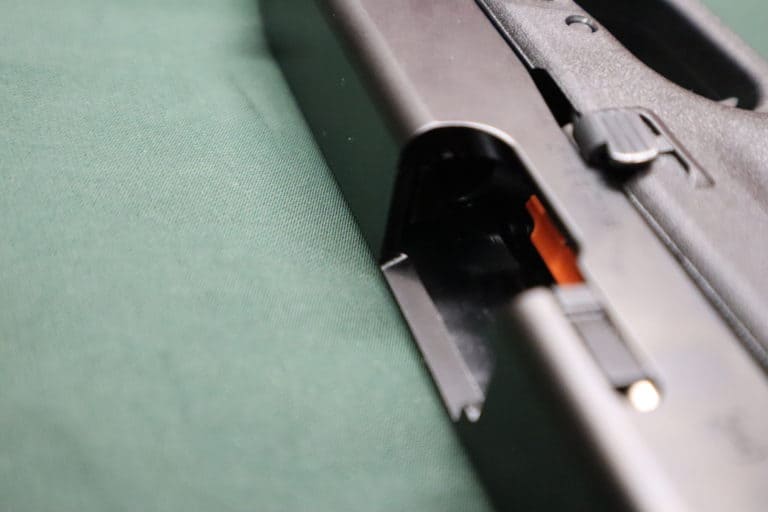
- EXTERNAL SAFETY – A safety lever found on the exterior of some firearms. A mechanical device that can be controlled by the shooter meant to stop the firearms ability to fire.
- EYES – Slang term for eye protection. Some sort of glasses to be worn in front of your eyes while shooting. They are mandatory at nearly every shooting range and should always be worn while shooting. YOU MAY HEAR: “Alright shooters, put on your eyes and ears, the range is going hot.”
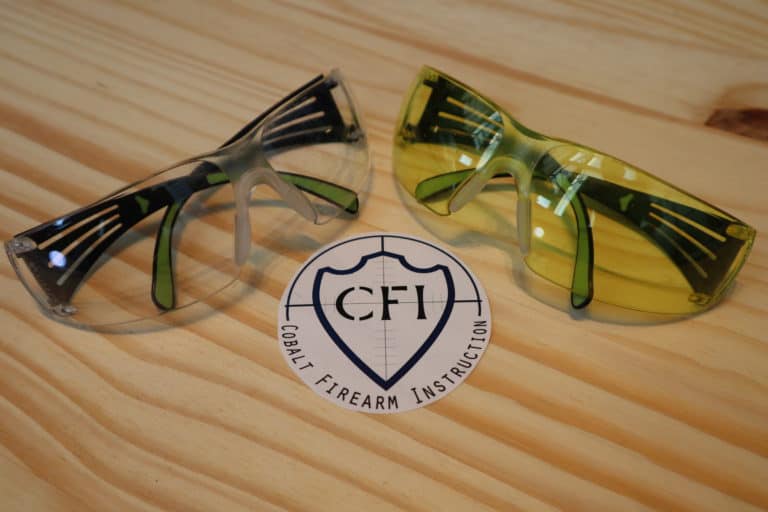
- EYE DOMINANCE – Also known as “ocular dominance” or “eyedness”. Eye dominance indicates which eye is stronger (which eye’s visual input is “preferred” by the brain) and should therefore be the eye you leave open if you close one eye when shooting.
- EXTRACTOR – A part of the firearm that serves to remove the spent brass cases of ammunition after it has been fired. When your handgun’s action cycles upon firing, the extractor lifts or removes the spent brass casing for the firing chamber and ejects it from the handgun.
F
- FACTORY AMMO – Mass produced ammunition by commercial vendors sold in retail stores.
- FAILURE TO EXTRACT – A malfunction in which the extractor of a semi-automatic firearm fails to move the spent casing out of the way as the slide moves back. Note: A failure to extract often causes double-feed malfunction.
- FAILURE TO FEED – A malfunction in which the slide of a semi-automatic firearm passes over the next cartridge in the magazine and fails to pick it up to insert into the chamber as the slide returns to battery.
- FAILURE TO FIRE – A broad term for any malfunction where the trigger has been pulled and no shot is fired as a result.
- FIREARM – A rifle, shotgun or handgun using gunpowder as a propellant.
- FIRING PIN – A skinny metal part of modern-day firearms used to strike the primer of the loaded cartridge with great force.
- FLARED MAG-WELL (MAGAZINE WELL) – A wider, “flared”, sloped opening at the base of the grip of a semi-automatic handgun where you insert a magazine into the firearm. Typically an aftermarket upgrade used on competition and defense handguns. Allows for a larger margin of error when trying to quickly load a new magazine on the go.
- FLASH HIDER/FLASH SUPPRESSOR – A muzzle attachment to reduce visible muzzle flash caused by exploding gasses.
- FLINCH – A preemptive downwards jerk of the gun right before the shot is fired. A common shooting mistake among new shooters who begin shooting a caliber larger than they’re comfortable with.
- FOLLOW THROUGH – Maintaining proper fundamentals after the shot has been fired. Maintaining good grip, stance, and trigger discipline while keeping an eye downrange on target(s).
- FRAME – The part of a handgun to which the action, barrel and grip are connected.

- FRONT SIGHT – The singular sight at the muzzle end of the barrel (furthest from the shooter when gripping the firearm to shoot.) Often a dot or a blade. Shooting Note: Clear front-sight focus is critical to shooting well. You should let your rear-sights and your target be blurry while the front remains clear and crisp.

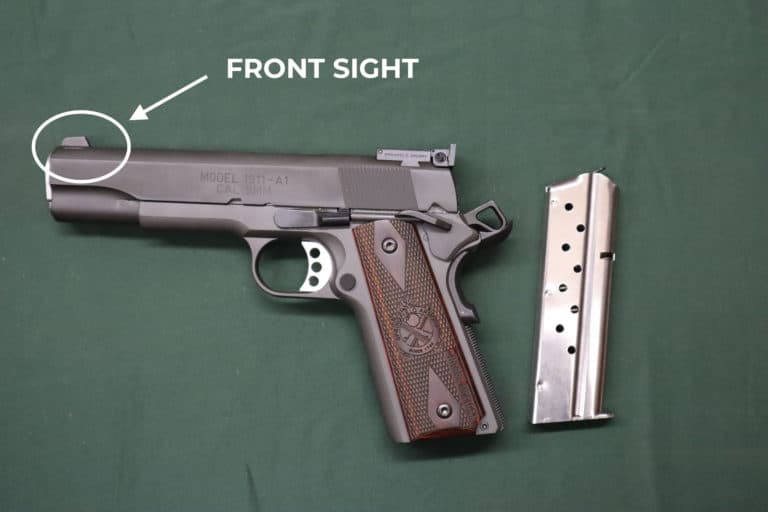
- FULL METAL JACKET or “FMJ” – A type of round in which the core (usually lead) is wrapped in a hard, metal jackets on all sides.
- FOULING SHOT – A fouling shot is a shot fired through a newly cleaned barrel, that is intended to leave some residue behind in the barrel and prepare the barrel for more consistent performance in subsequent shots. The first shot through a clean barrel behaves differently from subsequent shots through a barrel with traces of powder residue, this can result in a different point of impact of the bullet.
- FOULING – The accumulation of unwanted material on the solid surface of your firearm. Typically refers to the barrel (bore) of the handgun, but is applicable to all parts of the handgun, especially those parts integral to the cycling/loading/ejecting of your handgun. Fouling materials can consist of gunpowder residue, lubrication residue, or bullet materials such as lead or copper.
- FRANGIBLE BULLET – A bullet that is designed to break up into smaller pieces upon impact. These bullets are typically used to minimize the penetration into a target or as Breaching rounds.
G
- GAS OPERATED – A firearm that uses the superheated air created by burning gunpowder to work the action.
- GAUGE – The bore size of a shotgun determined by the number of round lead balls of bore diameter that equals a pound. It is used like “Caliber” for the shotgun.
- GRAIN – Is a unit of measurement used in firearms to denote amount of powder in a cartridge OR to denote the weight of the bullet. A grain of gunpowder is metrically expressed as 64.798 milligrams.
- GRIPS – The handle of a handgun. Often refers to the side-panels of the handle.
- GRIP PANELS – The interchangeable surfaces that are installed on the grip of the gun. Users usually change grip panels to improve the look and feel of the gun. Common grip-panel materials are wood, plastic, and rubber.
- GRIP SAFETY – A safety mechanism located on the rear of a handguns grip, that automatically “unlocks” the trigger as pressure is applied by the shooters hand.
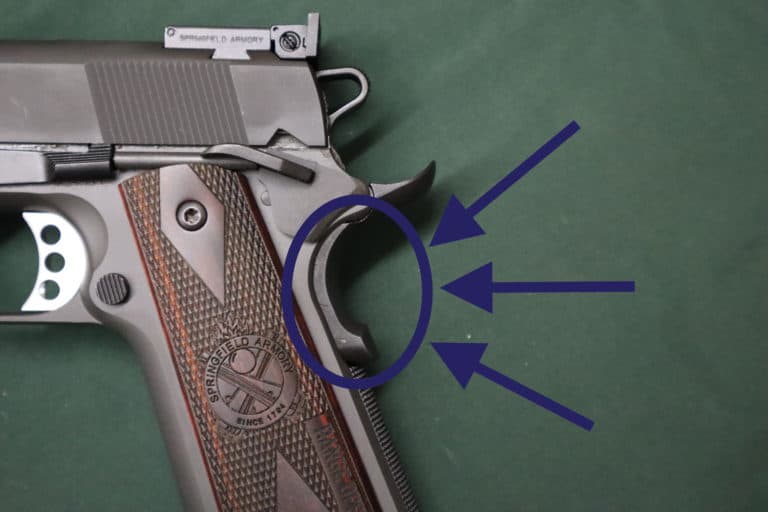
- GROUP or GROUPING – The pattern of shots on a target. Grouping is the product of the shooter repeating the same actions and getting the same results. The closer the holes or the smaller (tighter) the grouping, the better.

H
- HAIR TRIGGER – An extremely, extremely “light” trigger. A trigger that breaks from a very light touch.
- HANDGUN – Pistol and handgun are interchangeable. Can be fired with just one hand.
- HANG FIRE – An unexpected delay between pulling the trigger on a firearm and the ignition of the propellant. In layman’s terms, a delay between pulling the trigger and the shot firing.
- HAMMER – The component (on guns equipped with it) that rotates with great force to strike the primer. It will either have an attached firing pin or it will strike a separate firing pin. Either of which in turn strikes the impact-sensitive cartridge primer detonating the primer, and then the gunpowder within the cartridge.
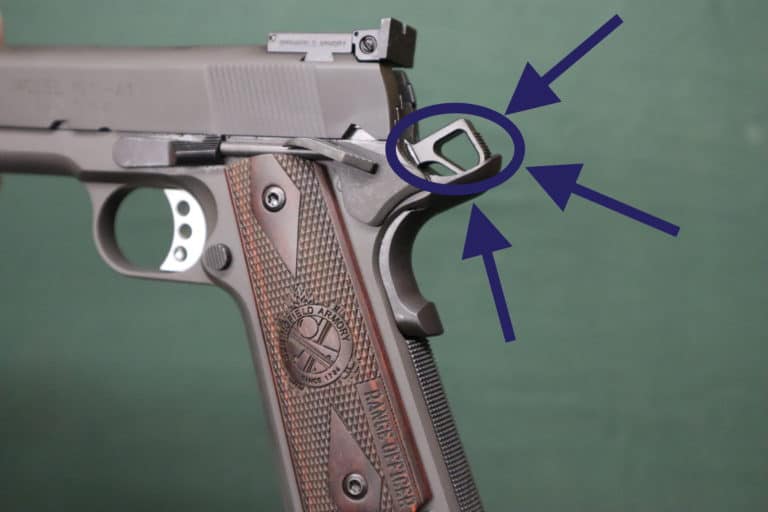
- HAMMER SPRING – Spring attached to the hammer which is compressed when the hammer is cocked. Tension drives the hammer forward to strike the firing pin or primer.
- HAMMERLESS – A revolver or pistol design that do have hammers but are fully encased and hidden inside the frames. These could be firearms designed where the hammer spurs have been removed for concealment, or striker-fired pistols that are truly hammerless.
- HANDLOADS – Cartridges assembled by an individual person from the individual components (primer, shell casing, gunpowder, and bullet). They are much more customized than Factory Ammo and take much more time to make.
- HEADSTAMP – A headstamp is the collection of markings on the bottom of a cartridge case. It usually tells who manufactured the case and what caliber of ammunition that it is. If it’s a military head stamp, it may also include the year of manufacture.
- HIGH-CAPACITY MAGAZINE – Not a precise term. A blanket description of any magazine holding more rounds than what is considered “average” for a given firearm.
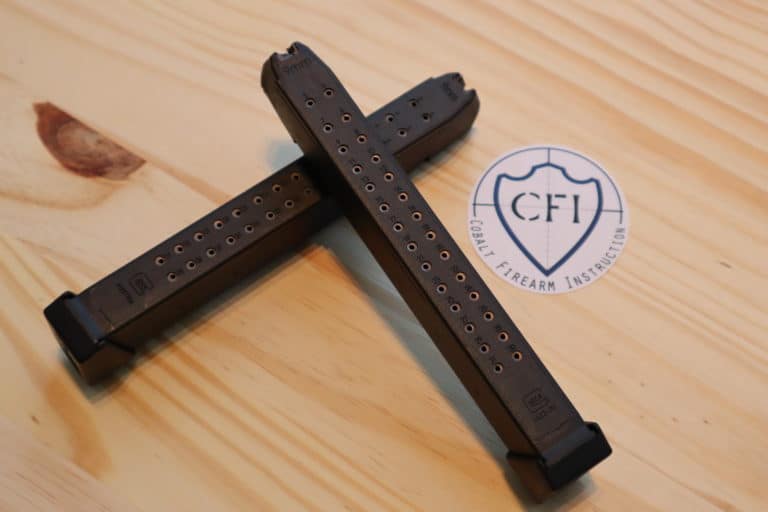
- HOLLOW-POINT BULLET – A bullet designed with a concavity in the nose, meant to expand to greater size on penetration of a solid target (won’t make a difference when shooting paper targets). Reduces the chance of over-penetration (shooting through the intended target and causing collateral damage beyond.) Very commonly used as self-defense ammunition.
- HOLSTER – A gun holder. You can affix them to yourself, your pack, or many other places. Made from anything from leather, to plastic, to Kydex. They securely hold the firearm in place while also serving to protect its finish and components from the elements/damage.

- “HOT” – See “hot range” below. The term “hot” often refers to things being in a state of being loaded and ready. If the weapon is “hot” it is loaded and ready to fire. If the range is “hot” people are in their lanes and shooting actively.
- HOT RANGE – A range where you are clear to fire. The Range Officer has deemed it safe to commence shooting and you are clear to handle and fire loaded firearms (safely.)
I
- INTERNAL SAFETY – Safeties such as drop safeties or magazine safeties located inside the firearm, not accessible from the outside to the user.
- IRON SIGHTS – The standard sighting system that typically comes attached to the firearm. Iron sights are composed of a rear sight mounted perpendicular to the shooter’s line of sight and consisting of some form of notch or opening between two peaks, and a front sight that is typically a post, bead or ring mounted at the front (Muzzle) end of the firearm on top of the slide.
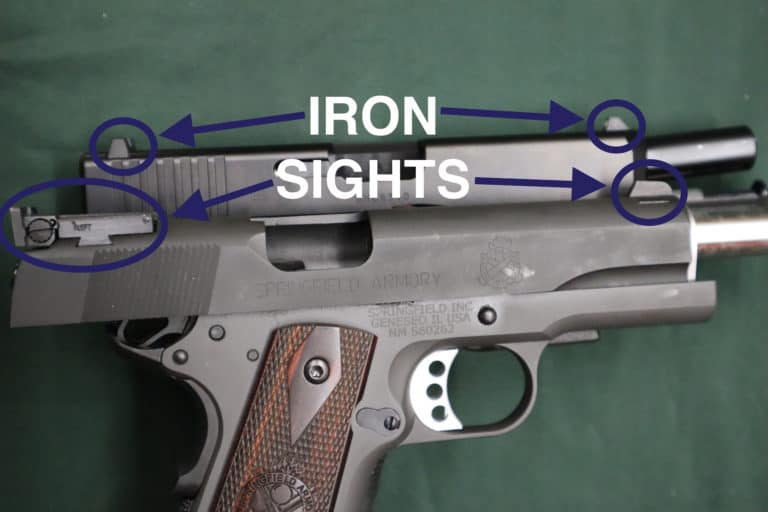
- ISOSCELES STANCE – A shooting stance where feet are shoulder width apart, both facing your target, both arms are thrust forward holding the gun towards the target.
J
- JACKET – The enveloping material that is wrapped around a lead core to form the bullet (projectile) element of the cartridge.
- JAM – A malfunction which locks up the gun to the point that it needs to be addressed with tools. Often used as a blanket term for all gun malfunctions that impede shooting.
K
- KEYHOLE – An odd-shaped hole in the target (sometimes it can look twice as large as a normal hole caused by your bullet) caused by a bullet which was unstable during its flight and entered the target sideways rather than head-on.
- KICK – Term for the recoil, or backward momentum, generated by a firearm when it is discharged.
L
- LANDS – Raised portions of the bore left between the grooves that were cut into the bore of a firearm during the rifling process.
- LEAD – The metal from which most bullets are typically made. They may also be made of steel, or other materials.
- LENGTH OF PULL – This can mean 1 of 2 things: 1) The distance between the trigger and the rearmost surface of the gun.(for rifles this would be from the front of the trigger to the butt) 2) The distance you must pull the trigger before you can fire a shot.
- LEVER-ACTION – Think: John Wayne’s rifle while he’s on a horse, or any old cowboy movie for that matter. A rifle action activated by manual operation of a lever. To eject the spent casing and bring a new,, live round into the chamber to be fired, the shooter must manually bring down the lever and close it back up.
- “LIMP WRISTING” – Not a compliment! A floppy, limp wrist while shooting. Can lead to malfunctions and lack of accuracy.
- LOADED – A firearm is loaded when a live cartridge (or live round) is in the chamber. For purposes of safety, every gun is always loaded 100% of the time and are treated as such.
- LOADED CHAMBER INDICATOR – A mechanical device that protrudes from the gun when a round is in the chamber and ready to be fired.
- LONG COLT or “COLT” – Long Colt is a type of ammunition, most commonly you will see it referred to in the context of “.45 Long Colt” or “.45 Colt” which mean the same thing, and are very different from the far more common “.45 ACP” ammunition.
- LONG GUN – A blanket term for both rifles and shotguns.
- LONG TRIGGER – A trigger which has to travel a long distance before a shot can be fired (see “length of pull”.)
- LR – “Long Rifle”, a type of ammunition. Common example: .22LR, one of the most common types of .22 ammunition
M
- MAGAZINE – Magazines are the ammunition storage and feeding mechanisms. Magazines may be internal and attached to the firearm (fixed) or removable (detachable).


- MAGAZINE DISCONNECT – Sometimes called a magazine safety. A mechanism that prevents the gun from being able to fire when the magazine is removed from the gun.
- MAGAZINE WELL – Also called “mag-well”. The opening in the bottom of the gun into which a magazine is fed. On a handgun (semi-auto), the magazine well is at the base of the grip.
- MAGNUM – A term for a relatively heavily loaded cartridge and also a term for a gun built to safely fire it. Be warned: A magnum round is not interchangeable with a non-magnum round. You cannot shoot a .22 Magnum (.22WMR) out of a .22 LR Rifle.
- MARKSMANSHIP – The ability of a shooter to consistently strike the target at a desired point of impact.
- MANUAL SAFETY – A device or mechanism designed to impede the ability to shoot a firearm. Must be removed or set to “fire” before the user can fire the gun. The most common form of safety mechanism is a switch that, when set to the “safe” position, prevents a pull of the trigger from firing the firearm.
- MATCH GRADE (“MATCH”) – Firearm parts and ammunition designed to a higher quality specification for competitive shooting.
- MISFEED – When the next round fails to completely enter the chamber properly. Do not confuse with “failure to feed”. A failure to feed is when the next round is never pulled from the top of the magazine, while a misfeed is a round that is removed from the magazine but does not enter the chamber properly.
- MISFIRE – When a cartridge fails to fire after being struck by the firing pin.
- MOUSE GUN / MOUSE CALIBER – A name for any small-sized handgun which fires a small caliber round of ammunition (i.e: .25acp, .32, etc.)
- MUZZLE – The end of the barrel from which the bullet (projectile) exits.

- MUZZLE BRAKES or “RECOIL COMPENSATORS” – A device that is fitted to the muzzle of a firearm whose purpose is to redirect the propellant gasses away from the handgun. The effect of which counters both the recoil of the handgun as well as the unwanted rising of the barrel during rapid firing.
- MUZZLE JUMP or MUZZLE CLIMB or MUZZLE FLIP – The vertical movement of the muzzle (front-end of the firearm) when the handgun is fired. Closely associated with “recoil” and “felt recoil”.
- MUZZLE VELOCITY – Is the measurement of the speed at which a projectile leave the muzzle of a firearm.
N
- NEGLIGENT DISCHARGE – The unintentional discharge of a firearm due to misuse, mishandling or irresponsible behavior by the user.
- NIGHT SIGHTS – A type of iron sights that glow in the dark, intended for use in low light and dark conditions. Many make use of phosphorous paint, some use tritium tubes which are much more expensive.
- NRA – National Rifle Association. American organization whose goals include firearm safety training, marksmanship training, the protection of the second amendment rights of US citizens, etc.
O
- OFFHAND or OFFHAND SHOOTING – Can mean one of 2 things: 1.The act of shooting while standing, unsupported (rifle shooting). 2. Shooting with one’s non-dominant hand (pistol shooting.)
- OUT OF BATTERY – A semi-automatic is “out of battery” when the slide fails to come all the way forward again after the gun fires. The cause of this can be anything from a misfeed, dirt buildup in your gun, worn-out springs, improper closing of the slide (“riding the slide”) and more.
P
- +P AMMUNITION – Is small arms ammunition that has been loaded to a higher internal pressure than typical for its caliber. Many calibers are available in both standard and +p or +p+ variants. Ammunition marked +p produces more power and higher pressures than the standard ammunition. Note: Not all firearms are built to specifications that can handle
- PATCH – A small piece of cotton or rag used to clean the inside of a barrel.
- PICATINNY RAIL – A bracket attached to firearms that provides a standardized mounting platform for accessories such as scopes, lights, or lasers with specific measurements and accuracy. Picatinny-type rails for accessories such as flashlights and lasers commonly seen on handguns under the barrel on the underside of the frame beneath the muzzle.
- PISTOL – Synonymous with “handgun.” (definition above)
- PLINKING – Informal target shooting done at non traditional targets such as tin cans, glass bottles, ballons, etc.
- POA – Point of aim. The spot on your target where you are aiming to hit.
- POI – Point of impact. The spot on the target where the bullet (projectile) actually hits.
- POINT SHOOTING – Shooting without fully using the sights. Most commonly used by self-defense shooters when engaging targets at close range or when there is no time to fully extend your arms.
- PORTING – Openings at the muzzle end of the gun. Some of the spent gases can escape through these openings, reducing perceived recoil and lessening muzzle rise. Porting will increase the noise and flash.
- PRE-TRAVEL – The “slack” in the trigger that the shooter pulls through before tension is felt as the hammer or striker begins to retract. All of the movement before the trigger starts to engage.
- PRIMER – The ignition component of a cartridge. Small metal cup in the bottom of the casing that contains a small amount of explosive charge. When struck by the firing pin, it ignites the gunpowder, starting the explosion that fires the round.
- PRINTING – When the outline of the concealed handgun can be seen through the outer clothing.
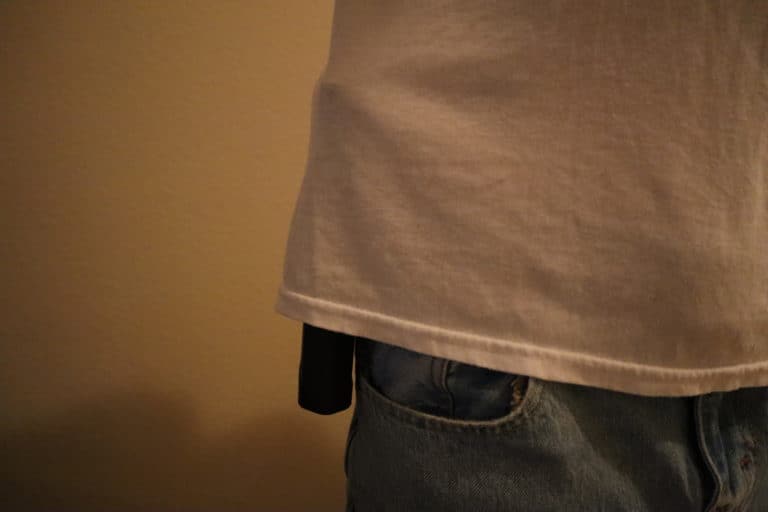
- PROJECTILE – See “Bullet” above. The top most component of the cartridge. The part of the cartridge which is shot from the handgun when it is fired.
- PROPELLANT – The chemical compound ignited by the primer to generate gas. (Gunpowder)
- PULL – The process of bringing the trigger from its resting position all the way through the trigger break.
- PULL DISTANCE – The distance the trigger travels before it reaches the break point and the gun fires.
R
- RACKING THE SLIDE – pulling the slide back to its rearmost position, and then letting it go forward. Do not let your hand rest on the slide when letting it return to its forward position, the spring tension will give it all of the force it needs. Racking the slide loads the chamber and prepares the gun to fire (in a semi-automatic handgun.)
- RAIL – Found on the underside of the frame below the barrel, allowing various aftermarket accessories to be attached the gun, like flashlights or lasers.
- RAILS – When it’s plural, RAILS refers to the metal surfaces upon which a semi-automatic’s slide travels back and forth each time a shot is fired.
- REACH – The measurement from the backstrap (rear-most portion of the handgun grip) to the face (front) of the trigger.
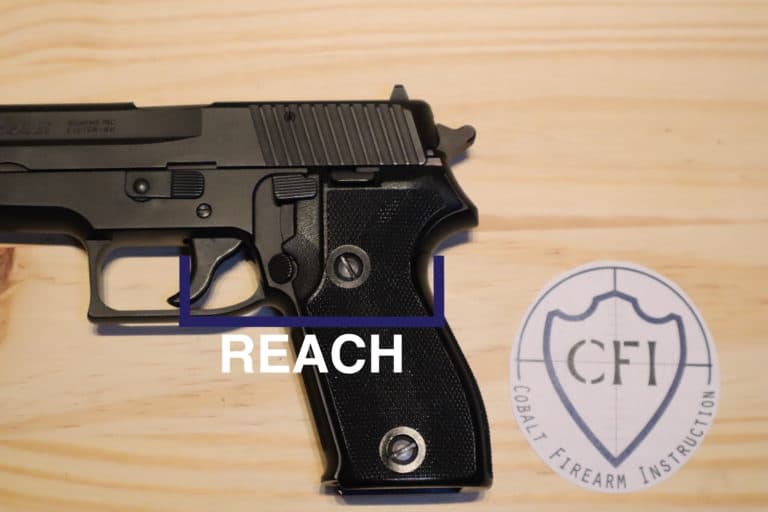
- RANGE SAFETY OFFICER or RSO – The person in charge of the operations and safety on a shooting range. Also Known As: RO, or RANGE OFFICEER.
- RATE OF FIRE – The speed at which a firearm fires its projectiles. Typically associated with automatic weapons and machine guns. Can also refer to: the speed at which a shooter fires their firearm.
- REAR SIGHT – The rear sight is placed at the end of the barrel nearest the shooter. It can be in a variety of shapes: a square notch, a U, a V, or simply two dots designed to be visually placed on either side of the front sight while shooting to maintain good sight-alignment.
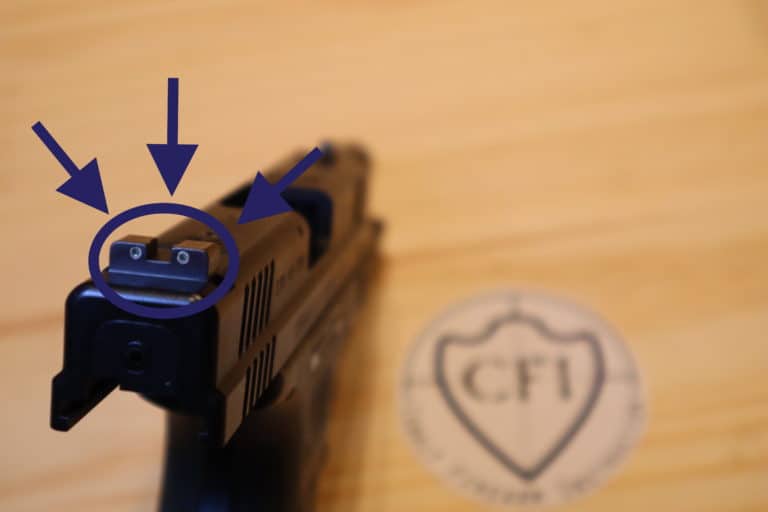
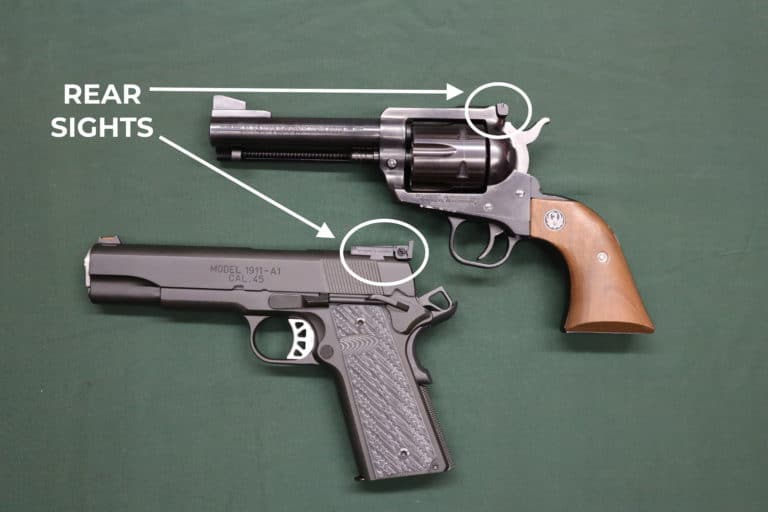
- RECEIVER – The part of the firearm that houses the operating parts of the firing mechanism. Often referred to as the “frame” when talking about a handgun.

- RECOIL – (see also kick) The backward momentum developed by a gun upon its firing. The faster the bullet leaves the muzzle and the more it weighs, the more felt recoil.
- RECOIL SPRING – The powerful spring that cushions the slide as it travels rearward when a shot is fired. It is responsible for sending the slide forward again with enough force to drive the fresh round firmly into the chamber.
- RED DOT SIGHT – A type of optical sight for firearms that gives the user a red light emitting diode as a reticle to create an aimpoint. Mounted on top of the slide (semi-automatic) or frame, above the cylinder (revolver) a red dot sight provides faster target acquisition.
- RELOAD – Can mean 1 of 2 things. 1. To refill the firearm with ammunition (through a loaded magazine or individually reloading the empty revolver chambers) in order to continue shooting. 2. When a shooter uses empty brass cases that have already been shot and fills them with new primers, powder, and bullets to make fresh hand loaded ammunition.
- RESET – The point of the trigger’s return-travel after a shot has been fired, at which the gun’s internal mechanisms are ready to fire another round. Often accompanied by an audible and tactile “click”.
- RETICLE – Lines or markings in an eye piece such as a scope. Typically crosshairs or a dot that the shooter uses to align the shot.
- REVOLVER – A repeating firearm that has a rotating cylinder containing multiple chambers and at least one barrel for firing.
- RICOCHET – A bounce, skip, or rebound off of a surface by a bullet (projectile), redirecting its flight path.
- RIDING THE SLIDE – A common and INCORRECT way of racking the slide (see above) Allowing your hand to rest on the slide as it moves forward during the loading procedure. This action takes away much needed energy from the slide’s movement and commonly causes misfeeds and other malfunctions.
- RIFLING – The helical (spiral) grooves in the barrel of a firearm designed to impart a stabilizing spin to the projectile around its long axis. This spin serves to gyroscopically stabilize the projectile, thereby improving its aerodynamic stability and accuracy.
- RIMFIRE – A type of firearm cartridge that uses a firing pin to strike the cartridge base’s rim as opposed to a primer cap in the center of the casing (centerfire). The priming compound is located inside the rim of the case (hence the name rimfire.)
- ROUND (see also AMMUNITION or CARTRIDGE) – Synonym for a single cartridge.
- ROUGH TRIGGER – A derogatory term about the quality of a trigger. Said about a trigger that has an almost gritty, inconsistent, or difficult feel to it during the pull.
S
- SAFE (describing a condition) – A firearm is “SAFE” when the safety is engaged. This is not necessarily an indication that the firearm has been cleared (see “clearing” above) there may still be ammunition in the gun when it is “safe” and is still to be treated as if it is loaded at all times.
- SAFE (describing an object) – A locking container, ranging in size from small (holding a single handgun) to very large (able to hold an entire firearm collection from rifles to handguns and more.
- SAFETY – Any mechanism used to prevent the accidental discharge of a firearm by blocking the firing pin or the trigger.
- SCOPE – A magnifying optic tube through which the shooter looks to see a target closer-up than it actually is. Scopes have a reticle (see above). Scopes are commonly mounted on the top of the firearm towards the rear. They are far more commonly used with rifles as opposed to handguns. Scopes must be “zeroed” before they can be used properly to improve accuracy.
- SEAR – The part of the trigger mechanism which holds the hammer or the striker back. Applying pressure to the trigger causes the sear to release the hammer or striker, allowing it to strike the firing pin and subsequently discharge the weapon.
- SELECTIVE–FIRE – A firearm that can shoot multiple ways, selected by the user. Modes of fire typically include: semi-automatic, automatic, and burst.
- SEMI–AUTOMATIC – A firearm that: fires a single round, ejects the empty case, and reloads the chamber, every time the trigger is pulled. Semi-automatics use the energy from the fired round to achieve the above described action.
- SEMI–WADCUTTER (SWC) – A bullet design with a conical extended nose with a flat point, and a sharp edged shoulder that serves to cut a full diameter hole in the target.
- SHELL – An empty ammunition case.
- SHORT TRIGGER – A trigger that doesn’t have to travel very far before it reaches the break.
- In 1911’s a short trigger vs long trigger refers to the actual size of the trigger, short giving you a shorter reach (see above) and long being the opposite.
- SHOOTING RANGE – A specialized facility designed for firearms practice. Can be indoors, outdoors, and can cater to a wide variety and styles of shooting (tactical, marksman, etc.)
- SHOT GROUPING – The pattern of impact of multiple projectiles (bullets) on the target in one shooting session. The tighter the grouping (closer together all of the rounds fall), the more skilled the shooter and more precise the weapon is.
- SIGHTS – A device affixed to a firearm that is used to help acquire or magnify the target. Can be mechanical (iron sights), optical (scopes), electronic (red dot), and more.
- SIGHT ALIGNMENT – The manner in which the sights (front & rear) are lined up properly in relationship to one another in front of the shooter, forming a straight path to the target. Proper sight alignment is achieved when the front sight rests evenly between the two rear sights and sits at the exact same height.
- SIGHT RADIUS – The distance between the front and rear sights. Common wisdom dictates that a longer “sight-radius” (more space between the rear and front sights) leads to improved accuracy. This is due in large part to geometry, angles, how large your front sight appears in relationship to the target. Email us directly for a more in-depth explanation.
- SIGHT PICTURE – What the shooter sees when looking down (or through) their sights at the target. The point of aim where the sights rest on the target.
- SILENCER – The proper term is a “suppressor”. A device that is used to reduce the sound of a firearm’s discharge. They lower the intensity of the muzzle blast and change the sound characteristics. The purchase and ownership of suppressors is highly regulated in the U.S. Contrary to what’s commonly seen in Hollywood, suppressors do not actually “silence” a firearm’s report.
- SINGLE–ACTION (SA) – A pistol or revolver, in which the trigger is only used for firing the gun, and never used to cock the firing mechanism (like in a double-action firearm). On single-action revolvers, the hammer must be manually drawn back to full cock for each individual shot. On single-action pistols, the recoil action will automatically re-cock the hammer for the all subsequent shots after the first. The hammer may be cocked by hand, or by racking the slide, or by the rearward movement of the slide after each shot is fired.
- SLACK – Term commonly interchangeable with “pre-travel”. To ‘take up the slack’ means to pull the trigger through its pre-travel (see above) stage.
- SLAMFIRE – A premature, accidental discharge of a firearm that occurs as a round is being loaded into the chamber.
- SLIDE – The upper portion of a semi-automatic pistol that houses the barrel, breechblock and portions of the firing mechanism. The slide is responsible for ejecting the spent case as it moves to the rear and loading a fresh round into the chamber as it moves forward again. It slides along tracks on the top of the frame during the recoil process.
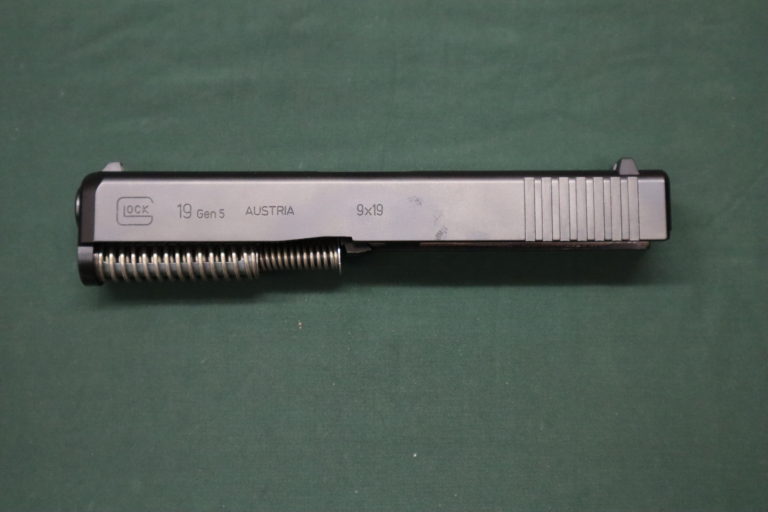
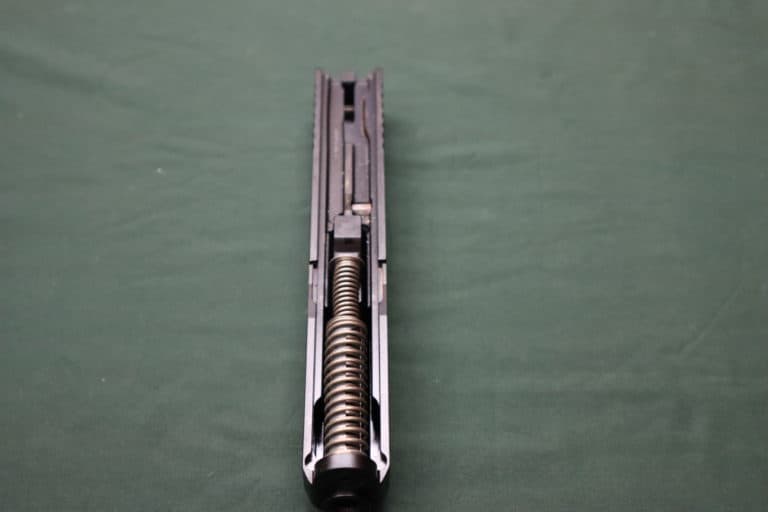
- SLIDE BITE – The abrading, or cutting of, the web, back, or thumb of the hand caused by the rearward action of a semi-automatic firearm’s slide. Often caused by improper grip and firearms not suited to the size of the shooter’s hand.
- SLIDE LOCK – Can mean 1 of 2 things: 1. When a semi-automatic firearm has been fired until the magazine is empty and the slide locks open. This condition is called “slide lock” 2. What certain instructors and shooters will call a slide release (see below). Some instructors train their students not to use the slide release to close the action (release the slide forward) for a varying number of reasons, so they avoid calling the mechanism a “slide-release” to avoid any confusion or reinforcement of “bad” behavior.
- SLIDE RELEASE – The slide release lever is usually located on the left side of the slide. It is pushed down to unlock the slide and release it, allowing it to move forward into its normal position. As stated above, this mechanism is often called the “slide stop” or “slide stop lever”.

- SNAP–CAP – An inert (un-shootable) ammunition-shaped object. Used in practice for all sorts of purposes, from simulating misfeeds, to assisting in dry-fire practice and other training exercises.
- SNUB NOSED REVOLVER or “SNUBBY” – A revolver with a short barrel.
- SPEED LOADER – A device used for loading firearm or firearm magazines with loose ammunition quickly.
- SPOTTING SCOPE – A high powered scope used to locate shot placement on targets. Typically not necessary in handgun shooting.
- SQUIB LOAD or SQUIB or “POP AND NO KICK“ – A malfunction in the cartridge normally associated with little or no gunpowder in the case. The shooter pulls the trigger, hears the pop from the cartridge primer but with little or no follow-up explosion of the gunpowder in the casing. The force of the primer exploding can lodge the bullet (projectile) in the barrel. Firing immediately after experiencing a squib load without taking steps to clear any potential blockage can cause serious damage to the firearm and potential grave damage to any shooters in the vicinity.
- STANCE – How the shooter positions his or her body while they shoot. (Common examples are Isosceles and Weaver)
- STOCK – Can mean one of two things: 1. A firearm that has not been altered or upgraded since it was built and shipped from the factory. 2. The back part of a long gun, not including the receiver, made of wood, metal or plastic.
- STOVEPIPE – Failure of a spent (fired) case to completely eject from a semi-automatic firearm. The case usually stands on end while lodged in the ejection port, sometimes making it look like an old-school stovepipe, hence the name.
- STRIKER – In handguns without a hammer. A linear, spring loaded cylindrical part that strikes the primer of a loaded (chambered) round of ammunition. A striker does the work of both the hammer and firing pin found in pistols with hammers.
- STOPPING POWER – A somewhat vague term referring to the ability of a cartridge to incapacitate an animal or human assailant. Stopping Power has never been precisely defined, though a rather in-depth look at the subject is put forward in a youtube video titled “The Best Handgun Caliber – A Real World Study.”
- SUPPRESSOR – See “silencer” above. The proper term for a “silencer” is a suppressor. A device that lowers the intensity of the muzzle blast caused by firing the gun.
T
- “TAP, RACK, BANG” – A slang term commonly used by the military and law enforcement community for the procedure to clear a misfeed. It refers to the following procedure: 1. Tap the base of the magazine firmly, making sure it is properly seated. 2. Rack the slide to eject the blockage and feed a new round into the chamber. 3. If a threat still remains that needs to be dealt with, pull the trigger (bang).
- THUMB SAFETY – An external, manual safety which you typically disengaged with the firing-hand thumb (think about a 1911 for a good example).

- TRAJECTORY – The arc of projectile traveling from the muzzle (point where it leaves the firearm) to the point of impact (where the bullet hits the target).
- TRIGGER – The mechanism that causes the firing sequence of a gun. Normally pulled by the index finger. The pulling of the trigger will activate the hammer or the striker, thus beginning the firing of the chambered cartridge in the firearm.
- TRIGGER CONTROL – Can refer to 1 of 2 things: 1. Keeping your finger OFF OF THE TRIGGER until your sights are on target. 2. Pulling the trigger to the rear smoothly with with great control. Having good trigger control (as referred to in #2 above) is a critical fundamental to accurate shooting, no matter the firearm.
- TRIGGER GUARD – A bow-shaped band of metal or plastic (typically) that surrounds the trigger to prevent accidental discharge of the firearm.
- TRIGGER LOCK – A locking device put on a firearm to render it un-shootable (to use the EXTREMELY technical term).
- TRIGGER SAFETY – (Think Glock, or Springfield handguns.) An external safety protruding from the trigger that must be depressed to allow the gun to fire. The intention of a trigger safety is to make sure that someone is completely and purposefully depressing the trigger before the gun will be able to fire.
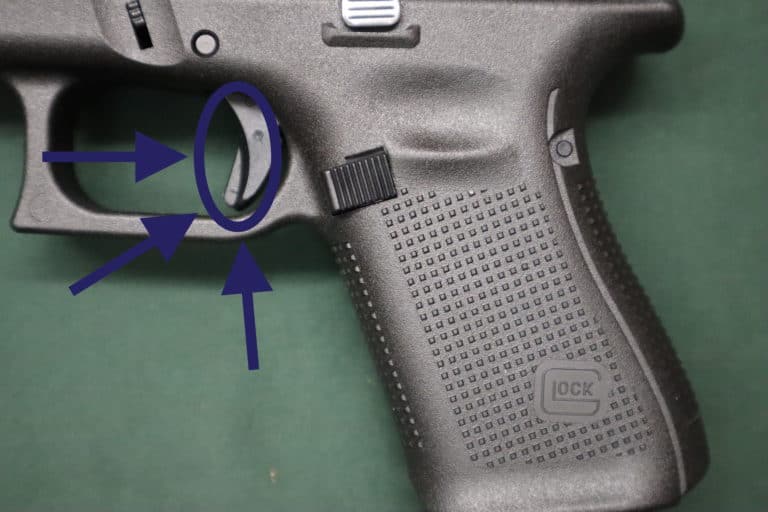
W
- WADCUTTER (WC) – A bullet designed with a flat head that is equal to the diameter of the round it is attached to. Used commonly in competitions due to the fact that they cut very noticeable and clean holes in paper targets.
- WEAPON – Any tool or object that can be used to inflict lethal force.
- WEAVER STANCE – A two handed pistol shooting stance named after Jack Weaver. The body is at an angle to the target, rather than facing it squarely. The off-hand leg points at the target and the dominant (shooting-hand) side leg is set back to the rear with the heels making a 90 degree angle to one another. The elbows are flexed. The dominant arm pushes out, while the weak hand pulls back. This stance is less commonly used in modern shooting for a variety of reasons, but still has distinct advantages, such as: presenting a smaller target to the enemy.
- WHEEL GUN – Common slang term for a revolver.
X
- X RING – A circle, usually annotated with an X in the middle of a target bullseye. Used to decide the winner of marksmanship competitions. If 2 or more shooters have the same number of hits in the 10 ring (bullseye), then the one with the most number of X RING hits (think “double bullseye” in darts) is the winner.
Z
- ZERO or ZEROING IN or ZEROED – ZEROING IN is the process of aligning your sighting mechanism so that the point of impact matches the point of aim at a specified distance. A firearm’s ZERO is the distance at which the point of impact will match the sights as they are set. A firearm/sight combination is ZEROED when the point of aim matches the point of impact at the desired distance.
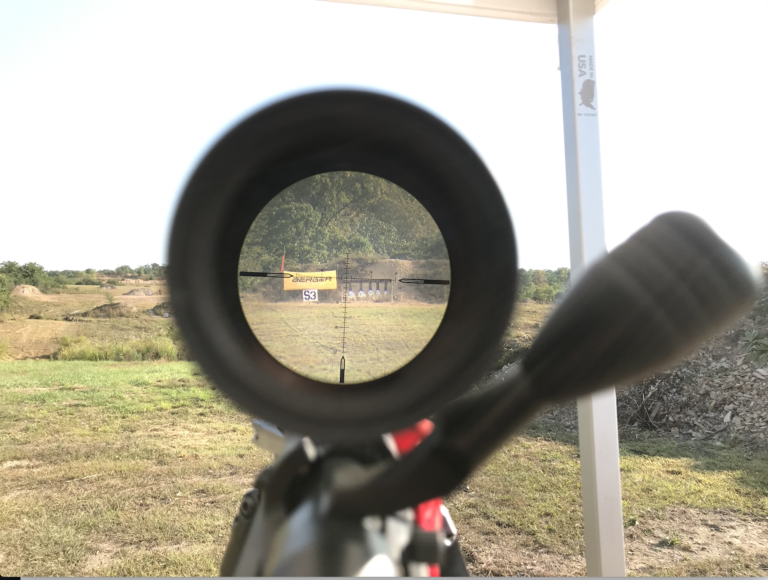
There you have it, folks!
We are always updating this list with the latest terms and phrases new shooters like you will want to know. Feel free to reach out and let us know if there’s something you’ve heard that you want to know about and we’ll research it, vet it, and get it on the list if it belongs there. If you know someone who could use this list, copy and paste the link below and SEND IT TO THEM.

